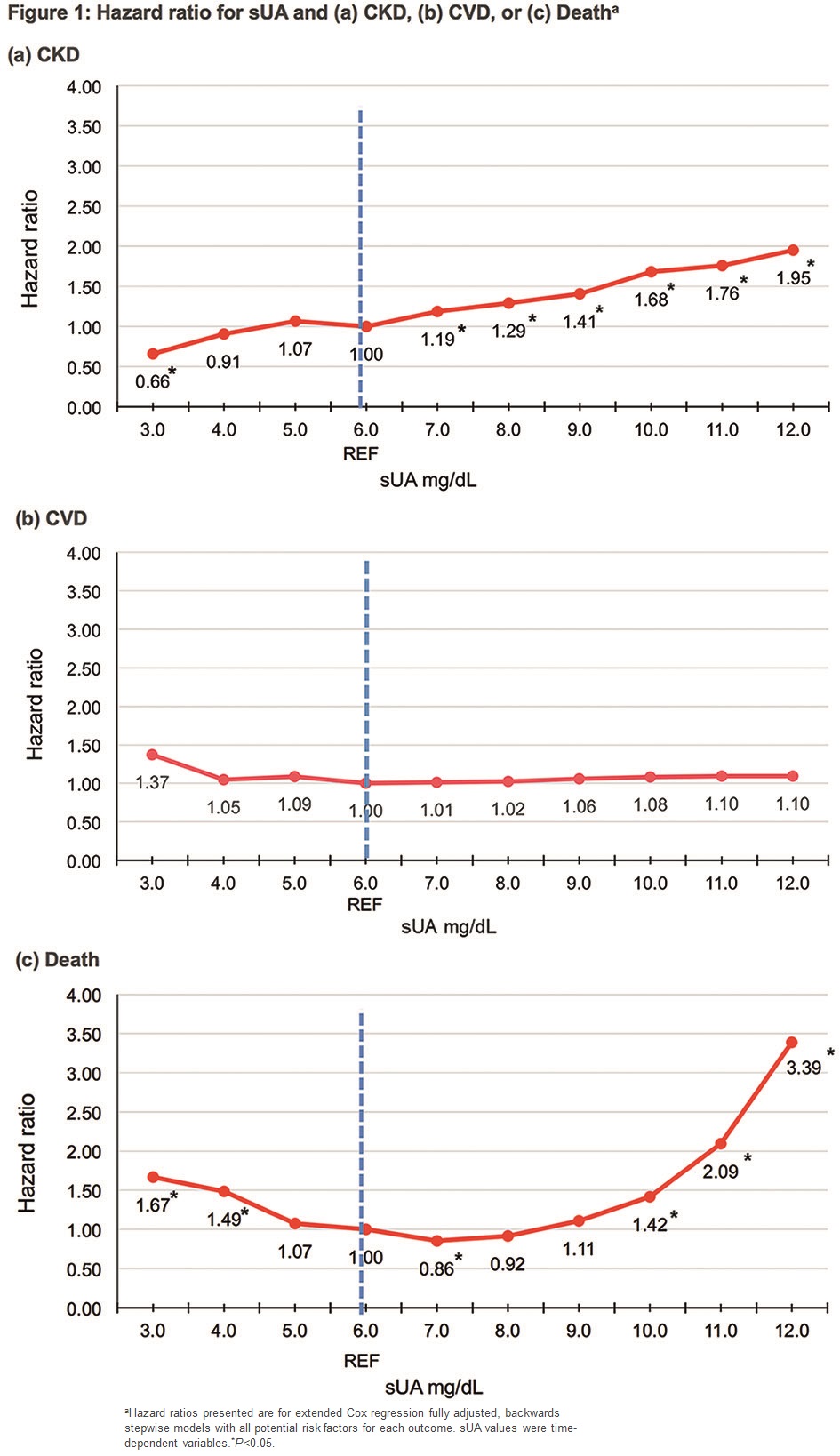Session Information
Date: Sunday, October 21, 2018
Title: 3S083 ACR Abstract: Metabolic & Crystal Arthropathies: Comorbidities & Outcomes (869–874)
Session Type: ACR Concurrent Abstract Session
Session Time: 2:30PM-4:00PM
Background/Purpose: Many studies have found that serum uric acid (sUA) levels are associated with the incidence of chronic kidney disease (CKD), cardiovascular disease (CVD), and mortality; however, these associations have not been studied among gout patients. As lowering urate is the mainstay of gout care, these associations would have implications for gout care and future research.
Methods: We conducted a cohort study using data from Clalit Health Services (Israel, January 2006–December 2015). Incident cases of gout were included from 1/2006 to 12/2009 among members aged ≥25 years and with continuous enrollment for ≥1 year prior to and ≥5 years after the first qualified gout diagnosis (the index date). Gout cases were identified based on the following criteria: a) 1 diagnosis of gout from a hospital or specialist visit; or b) ≥2 diagnoses of gout from 2 different general practitioner visits and either an elevated sUA (>6 mg/dL) or dispensation of colchicine or allopurinol. Exposure was assessed during the follow-up as: (1) the mean sUA; and (2) a summary measure of sUA above the threshold of 6 mg/dL, and then categorized as either no exposure (sUA-T0) versus quartiles of exposure (sUA-T1 to sUA-T4). We examined the association between time-updated prior sUA levels using either exposure measure and the risk of CKD, CVD, and mortality using extended Cox proportional hazard regression models adjusted for risk factors. Hazard ratios (HRs) were calculated relative to the reference group inclusive of 6 mg/dL.
Results: A total of 12,234 gout patients (mean age at diagnosis=64 years; 76.1% male) were followed for an average of 6.9 years. The mean sUA during the follow-up period was 7.4 mg/dL with sUA category-specific means of sUA-T0=4.4, sUA-T1=6.2, sUA-T2=7.2, sUA-T3=7.8, and sUA-T4=8.7 mg/dL. For CKD endpoints, risks increased with greater sUA exposure relative to a mean sUA of 6 mg/dL (Fig 1a) and for threshold categories versus sUA-T1 (HRsUA-T2=1.23, HRsUA-T3=1.34, HRsUA-T4=1.93; all P<0.001). For CVD endpoints, risks did not differ relative to mean sUA levels of 6 mg/dL (Fig 1b) or versus the threshold sUA-T1 (all P>0.05). For mortality, a U-shaped curve was observed for mean sUA exposure (Fig 1c) and for the low and high threshold categories versus sUA-T1 (HRsUA-T0=1.33, HRsUA-T4=2.08; all P<0.001).
Conclusion: These findings suggest a positive association between cumulative sUA burden above the target level of 6 mg/dL and CKD risk among gout patients. To that end, the sUA target of <6 mg/dL may provide reno-protective benefits among gout patients. Further, gout patients with extreme sUA levels are at risk for increased mortality.
1Richette et al. Ann Rheum Dis. 2017;76:29-42.
2Khanna, et al. Arthritis Care Res. 2012;641431-46.
To cite this abstract in AMA style:
Taylor DCA, Jaffe D, Hoshen M, Shefer G, Bachrach A, Feldman B, Fu AC, Choi HK. Is the Serum Uric Acid Therapeutic Target Protective of Chronic Kidney Disease, Cardiovascular Disease, and Mortality for Patients with Gout? a Longitudinal Study [abstract]. Arthritis Rheumatol. 2018; 70 (suppl 9). https://acrabstracts.org/abstract/is-the-serum-uric-acid-therapeutic-target-protective-of-chronic-kidney-disease-cardiovascular-disease-and-mortality-for-patients-with-gout-a-longitudinal-study/. Accessed .« Back to 2018 ACR/ARHP Annual Meeting
ACR Meeting Abstracts - https://acrabstracts.org/abstract/is-the-serum-uric-acid-therapeutic-target-protective-of-chronic-kidney-disease-cardiovascular-disease-and-mortality-for-patients-with-gout-a-longitudinal-study/

